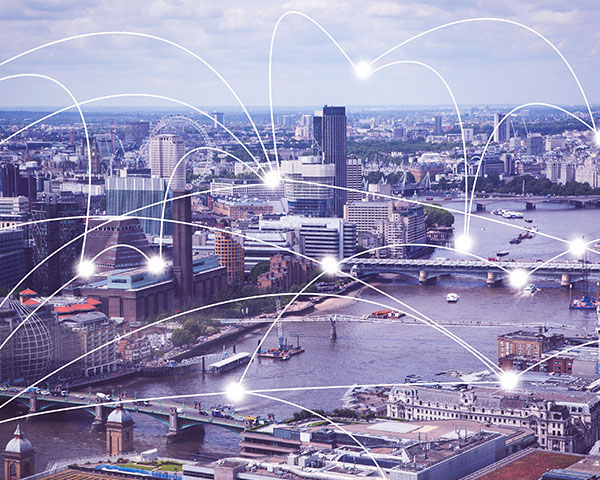INSIGHT
Has Covid-19 changed the meaning of
‘going to work’ forever?
Alison Bawn – People Director, Virgin Media Business
“We’re being forced into the world’s largest work-from-home experiment, and it hasn’t been easy.”
These were the words of Gartner’s Saikat Chatterjee back in March 2020, as the pandemic began to take hold in the UK.
‘Forced’ is the operative word here.
Any debate about whether large scale remote working was advisable – or even possible –quickly became redundant. Organisations had to make it work. The alternative didn’t bear thinking about.
As a result, we’ve experienced the biggest shift in our ways of working in centuries. Not something we chose. But equally something that many now don’t want to lose.
90% of employees who have worked at home during lockdown want to continue doing so even after Covid-19 is behind us, according to the Wales Institute of Social and Economic Research.
And our own research found that many employers feel similar.
67% of public sector organisations and 53% of private sector firms said they will continue with increased remote working in future.
In this article I’m going to explore what all this means for the future of work, the challenges it raises, and how you can overcome those challenges in your organisation.
The challenges ahead for hybrid working
When you break it down, the workforce goals for post-Covid organisations are really no different to before the pandemic.
You want your people to be effective. And you want them to be happy.
What has changed are the challenges involved in making sure that happens, with more people than ever working outside the office in so many different locations.
There are three key challenges to think about as hybrid working – a mix of remote and office-based work – becomes our new everyday in the coming months.
- Keeping employees engaged when they’re not together
- Empowering productivity anywhere and everywhere
- Protecting people’s wellbeing from afar
Let’s take a look at each of those in a little more detail.
Keeping employees engaged when they’re not together
Employee engagement has always been hard to achieve. And having none of your employees in the same room doesn’t make it any easier.
But as the past year has taught us, the lack of an office doesn’t have to be a barrier to achieving great things in the workplace. And engagement is no different.
As I mentioned above, all it takes is the right combination of culture and leadership, enabled by effective remote communication tools.
At Virgin Media Business we’ve launched a number of new initiatives to help people feel involved, motivated and part of one team.
We’ve started running virtual recognition events, calling individuals out for their contributions.
One of those events was called ‘The Big Night In’. We sent packages to people with drinks and takeaway vouchers to eat and drink during the ‘show’. There was live entertainment, prize giveaways and more. It was a lot of fun and a great way to replicate the social interaction we all miss from pre-Covid days.
Events like these are a really simple way to bring people together and make them feel valued, and the interactive nature means everyone gets involved.
It also encourages people to focus on the good work their colleagues have been doing, which adds to that sense of teamwork and supportive culture.
Another thing we’ve done is work even harder to have an open dialogue with our people and focus on what is going well and less well.
We regularly ask people for measured feedback on new ways of working and the impact it’s having on them, not just in terms of productivity but also their wellbeing. We are working hard to listen to how they are feeling and what they need as individuals.
Again, this is a simple way to keep track of engagement. If you don’t keep talking – and more importantly, listening – to the people you’re trying to engage, you’re not going to have much success.
Empowering productivity anywhere and everywhere
Empowerment starts with leadership and culture. But technology makes it possible.
When it comes to maintaining a productive hybrid workforce, you need to put the right tools in people’s hands – tools that enable them to do their job effectively wherever they happen to be.
That means taking a cloud-based approach.
Cloud communication platforms allow your staff to access all the information they need from a single location. They can even have the data they need integrated into applications they’re familiar with, like Microsoft Teams and Salesforce.
They can also host voice solutions that connect colleagues on any device, wherever they are, without switching between different apps and systems to chat to their colleagues or look for customer information.
This is hugely important when you’ve got people working in all different locations at all different times. They don’t have time to be spending hours on the phone to IT trying to make their technology work.
And having to flick between dozens of different systems and applications is only going to slow them down further, which in turn will have a negative impact on the customer experience.
Protecting people’s wellbeing from afar
No more long commutes. Better work/life balance. More time to spend on the things you want to do, from hobbies to exercise to moments with loved ones.
There are many ways remote working has benefited individual employees. But there is another, darker, side to the story we can’t ignore.
80% of Brits saying working from home has negatively impacted their mental health, according to Nuffield Health.
And 47% of managers fear their employees are at risk of burnout due to longer hours when working from home, another study by Robert Walters found.
At this stage it’s fair to say that increased remote working, at least on some level, is going to be a permanent feature of the UK workforce.
If you want to be a responsible employer, then, the onus is on you to help people work remotely in a way that doesn’t harm their wellbeing – just like you would if they were all still in the office.
In our organisation we’re constantly evolving the way we manage this. The transition has been easier for us than others as we already had a hybrid working policy in place before the pandemic, with the technology to support it. But even so, remote working on a scale like this is still relatively new ground.
We’ve already put in a framework with a number of simple guides to help people stay in control of their own wellbeing and empowering managers to look after their teams.
One thing we’ve done is encourage everyone to reduce their meetings from one hour to 45 minutes. This avoids those mentally exhausting days of back-to-back calls with zero breaks in between, giving people a little more room to breathe and a little more time to focus on themselves.
We’ve also had clear direction from our leaders to take a full lunch break, with people discouraged from booking in meetings any time between 12 and 1 if possible. It’s really important to have that clear message come from the very top of the organisation.
Technology has obviously played a huge role in helping us look after our people during these times.
Using video calls to read stories to colleagues’ children, for example, has been really effective at normalising the presence of people’s kids on work calls (not to mention a lot of fun!). Many of our teams are also connecting during walking 1:1s, so that people benefit from fresh air, some exercise and a clear head for a great conversation.
We’ve also been able to deliver lots of different coaching and learning sessions virtually, from wellbeing to resilience and time management.
And we’ve created our own internal wellbeing site called The Retreat, where people can get tips and advice on improving their wellness, whether that’s financial, mental, physical or anything else.
Perhaps most importantly, though, we’ve tried to stimulate everyday conversations between colleagues about how they’re feeling, how they’re coping and what needs to change, if anything.
In answer to the headline: yes, but a new and better everyday awaits
Now that people have experienced a world where life doesn’t always have to bend and sway to fit around work, there’s simply no going back.
It’s up to us as employers, and as individual employees, to work out the best way of approaching this new everyday. To understand how we can empower ourselves, our people and each other to do our best possible work, in the healthiest possible way, wherever we happen to be.
If we manage to do that, we could create a whole new way of doing things for generations to come.
A world in which work revolves around life, and everyone feels the benefits.
Share this article:
Download our top guides and reports
Latest insights
Empower
Put the right tools in people’s hands wherever they are, empowering them to do their job in a way that works for everyone






